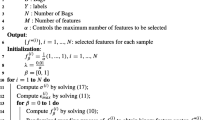Abstract
This paper introduces two approaches for solving Multiple Instance Problems (MIP) in which the traditional instance localization assumption is not met. We introduce a technique which transforms individual feature values in the attempt to align the data to the MIP localization assumption and a new MIP learning algorithm which identifies a region enclosing the majority (negative) class while excluding at least one instance from each positive (minority class) bag. The proposed methods are evaluated on synthetic datasets, as well as on a real-world manufacturing defect identification dataset. The real-world dataset poses additional challenges: data with noise, large imbalance and overlap.
Access this chapter
Tax calculation will be finalised at checkout
Purchases are for personal use only
Similar content being viewed by others
References
Alpaydin, E., Cheplygina, V., Loog, M., Tax, D.M.: Single- vs. multiple-instance classification. Pattern Recogn. 48(9), 2831–2838 (2015)
Amores, J.: Multiple instance classification: review, taxonomy and comparative study. Artif. Intell. 201, 81–105 (2013)
Andrews, S., Tsochantaridis, I., Hofmann, T.: Support vector machines for multiple-instance learning. In: Proceedings of the 15th International Conference on Neural Information Processing Systems, NIPS 2002, pp. 577–584. MIT Press, Cambridge (2002)
Bunescu, R.C., Mooney, R.J.: Multiple instance learning for sparse positive bags. In: Proceedings of the 24th International Conference on Machine Learning, ICML 2007, pp. 105–112. ACM, New York (2007)
Chevaleyre, Y., Zucker, J.-D.: Solving multiple-instance and multiple-part learning problems with decision trees and rule sets. Application to the mutagenesis problem. In: Stroulia, E., Matwin, S. (eds.) AI 2001. LNCS (LNAI), vol. 2056, pp. 204–214. Springer, Heidelberg (2001). https://doi.org/10.1007/3-540-45153-6_20
Dietterich, T.G., Lathrop, R.H., Lozano-Pérez, T.: Solving the multiple instance problem with axis-parallel rectangles. Artif. Intell. 89(1–2), 31–71 (1997)
Maron, O., Lozano-Pérez, T.: A framework for multiple-instance learning. In: Proceedings of the 1997 Conference on Advances in Neural Information Processing Systems 10, NIPS 1997, pp. 570–576. MIT Press, Cambridge (1998)
Ramon, J., Raedt, L.D.: Multi instance neural networks. In: Proceedings of ICML 2000, Workshop on Attribute-Value and Relational Learning (2000)
Ray, S., Craven, M.: Supervised versus multiple instance learning: an empirical comparison. In: Proceedings of the 22nd International Conference on Machine Learning, ICML 2005, pp. 697–704. ACM, New York (2005)
Ray, S., Page, D.: Multiple instance regression. In: Proceedings of the Eighteenth International Conference on Machine Learning, ICML 2001, pp. 425–432. Morgan Kaufmann Publishers Inc., San Francisco (2001)
Wang, J., Zucker, J.D.: Solving the multiple-instance problem: a lazy learning approach. In: Proceedings of the Seventeenth International Conference on Machine Learning, ICML 2000, pp. 1119–1126. Morgan Kaufmann Publishers Inc., San Francisco (2000)
Weidmann, N., Frank, E., Pfahringer, B.: A two-level learning method for generalized multi-instance problems. In: Lavrač, N., Gamberger, D., Blockeel, H., Todorovski, L. (eds.) ECML 2003. LNCS (LNAI), vol. 2837, pp. 468–479. Springer, Heidelberg (2003). https://doi.org/10.1007/978-3-540-39857-8_42
Zhang, Q., Goldman, S.A.: EM-DD: an improved multiple-instance learning technique. In: Advances in Neural Information Processing Systems, pp. 1073–1080. MIT Press (2001)
Author information
Authors and Affiliations
Corresponding author
Editor information
Editors and Affiliations
Rights and permissions
Copyright information
© 2018 Springer International Publishing AG, part of Springer Nature
About this paper
Cite this paper
Graur, DO., Mariş, RA., Potolea, R., Dînşoreanu, M., Lemnaru, C. (2018). Complex Localization in the Multiple Instance Learning Context. In: Appice, A., Loglisci, C., Manco, G., Masciari, E., Ras, Z. (eds) New Frontiers in Mining Complex Patterns. NFMCP 2017. Lecture Notes in Computer Science(), vol 10785. Springer, Cham. https://doi.org/10.1007/978-3-319-78680-3_7
Download citation
DOI: https://doi.org/10.1007/978-3-319-78680-3_7
Published:
Publisher Name: Springer, Cham
Print ISBN: 978-3-319-78679-7
Online ISBN: 978-3-319-78680-3
eBook Packages: Computer ScienceComputer Science (R0)




